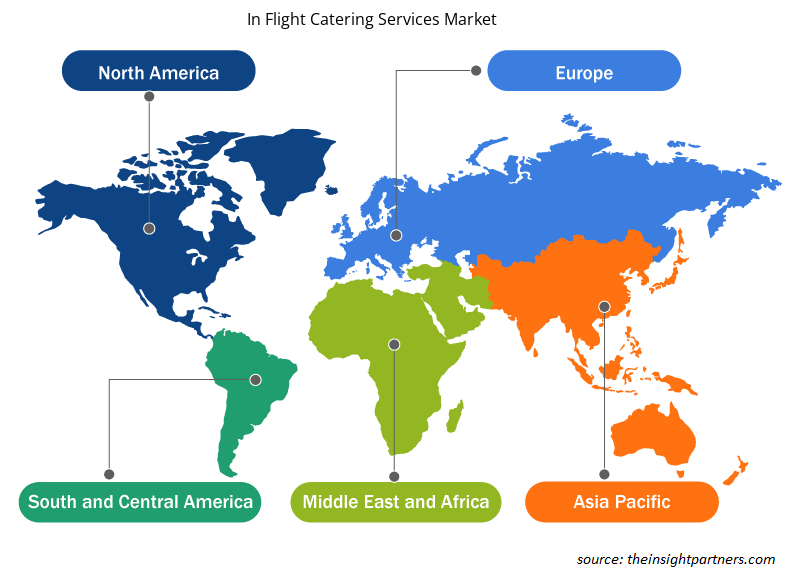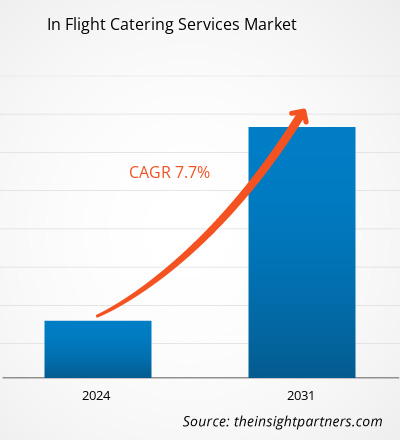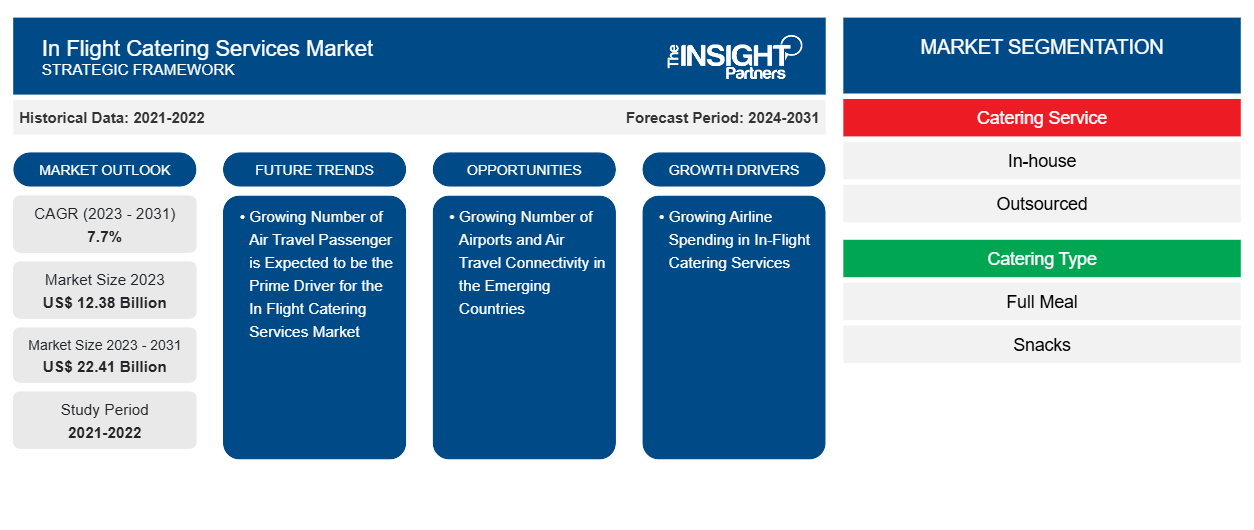Si prevede che la dimensione del mercato dei servizi di ristorazione in volo raggiungerà i 22,41 miliardi di dollari entro il 2031, rispetto ai 12,38 miliardi di dollari del 2023. Si prevede che il mercato registrerà un CAGR del 7,7% nel 2023-2031. Si prevede che la crescente richiesta di servizi di ristorazione a bordo per i voli a lunga distanza e la crescente preferenza dei consumatori per i viaggi aerei guideranno la crescita del mercato dei servizi di ristorazione in volo a livello globale nel periodo di previsione. Il crescente progresso tecnologico in termini di praticità di ordinazione e pagamento nel settore dei servizi di ristorazione in volo sta guidando la crescita del mercato dei servizi di ristorazione in volo a livello globale.
Analisi di mercato dei servizi di catering in volo
I servizi di catering in volo si riferiscono al cibo e alle bevande che le compagnie aeree forniscono ai loro clienti come servizi di bordo. Si prevede che la crescente attenzione dei consumatori per le offerte di servizi aggiuntivi oltre alle offerte di servizi di base delle compagnie aeree guiderà il mercato a livello globale. I clienti stanno optando per i servizi di catering in volo per i viaggi a lungo raggio e persino per quelli a breve distanza, il che si prevede influenzerà positivamente il mercato. Nei voli a lungo raggio, i servizi di catering in volo svolgono un ruolo chiave nel coinvolgimento del cliente, che distingue principalmente la compagnia aerea in questione dagli altri fornitori di servizi sul mercato.
Panoramica del mercato dei servizi di ristorazione in volo
La crescente preferenza dei consumatori per i viaggi aerei per tratte lunghe o brevi, insieme alla crescente preferenza per i servizi di catering specificamente per orari di volo insoliti, stanno agendo come principali motori per il mercato dei servizi di catering in volo. Si prevede inoltre che la crescente attenzione dei consumatori per viaggi convenienti e che facciano risparmiare tempo guiderà la crescita del mercato dei servizi di catering in volo a livello globale. L'elevato costo dei prodotti alimentari e la preoccupazione per il valore nutritivo dei prodotti alimentari in scatola potrebbero ostacolare la crescita del mercato dei servizi di catering in volo. Tuttavia, il crescente numero di passeggeri nazionali e internazionali potrebbe fungere da importante opportunità per il mercato dei servizi di catering in volo.
Personalizza questo report in base alle tue esigenze
Riceverai la personalizzazione gratuita di qualsiasi report, comprese parti di questo report, o analisi a livello nazionale, pacchetto dati Excel, oltre a usufruire di grandi offerte e sconti per start-up e università
-
Scopri le principali tendenze di mercato in questo rapporto.Questo campione GRATUITO includerà analisi di dati che spaziano dalle tendenze di mercato alle stime e alle previsioni.
Driver e opportunità di mercato per i servizi di catering a bordo dei voli
Si prevede che il crescente numero di passeggeri aerei sarà il principale motore del mercato dei servizi di ristorazione a bordo volo
La crescente preferenza dei viaggiatori per i viaggi aerei per brevi o lunghe distanze sta agendo come un importante motore per il mercato dei servizi di ristorazione in volo a livello globale. La crescente domanda dei consumatori di servizi aggiuntivi, come opzioni di cibo e bevande redditizie e opzioni di pasti per neonati nei viaggi a lungo raggio, sta anche avendo un'importante influenza positiva sul mercato. I viaggi aerei fanno risparmiare tempo e fatica, il che è una crescente preferenza dei consumatori per i viaggi aerei. Il crescente numero di viaggiatori aerei in tutto il mondo sta guidando la crescita del mercato a livello globale.
Crescente spesa delle compagnie aeree per i servizi di ristorazione a bordo
Le compagnie aeree si concentrano maggiormente sui servizi per soddisfare una base di clienti più ampia e attrarre nuovi consumatori. I servizi e i comfort offerti dalle compagnie aeree svolgono un ruolo degno di nota nell'attrarre i clienti. Sedili comodi, ampio spazio per le gambe, temperatura confortevole in cabina e offerte di cibo e bevande redditizie sono alcuni dei servizi di base a cui i clienti hanno diritto con l'acquisto dei biglietti. Oltre ai servizi generali, i clienti richiedono anche opzioni di cibo e bevande di buona qualità nei viaggi di lunga e breve durata. I fornitori di servizi delle compagnie aeree stanno investendo di più nell'acquisto di prodotti alimentari e snack di alta qualità con una varietà di opzioni per i loro clienti per fornire migliori servizi a bordo, il che dovrebbe aumentare la crescita del mercato nel periodo di previsione.
Analisi della segmentazione del rapporto di mercato sui servizi di catering in volo
I segmenti chiave che hanno contribuito alla derivazione dell'analisi di mercato dei servizi di catering a bordo sono il servizio di catering, il tipo di catering, la classe dell'aeromobile e il tipo di volo.
- In base al servizio di catering, il mercato è stato suddiviso in in-house e outsourcing. Il segmento in-house ha detenuto una quota di mercato maggiore nel 2023.
- In termini di tipo di ristorazione, il mercato è stato segmentato in pasto completo e spuntini. Il pasto completo ha dominato il mercato nel 2023.
- In termini di classe di aeromobili, il mercato è stato segmentato in prima classe, business class, premium economy ed economy. I segmenti economy hanno dominato il mercato nel 2023.
- In termini di tipo di volo, il mercato è stato segmentato in vettori full service e vettori low cost. I segmenti full service hanno dominato il mercato nel 2023.
Analisi della quota di mercato dei servizi di ristorazione in volo per area geografica
L'ambito geografico del rapporto di mercato sui servizi di catering a bordo di un aereo è suddiviso principalmente in cinque regioni: Nord America, Europa, Asia Pacifico, Medio Oriente e Africa e Sud America.
L'Europa ha guidato il mercato dei servizi di catering in volo nel 2023. La regione Europa comprende Regno Unito, Italia, Germania, Francia e Russia. Gli elevati investimenti in opzioni alimentari di alta qualità per il settore delle compagnie aeree stanno agendo come un importante motore per il mercato. L'elevata presenza di compagnie aeree e importanti fornitori di servizi di catering in volo stanno inoltre guidando la crescita del mercato in Europa.
Approfondimenti regionali sul mercato dei servizi di catering in volo
Le tendenze regionali e i fattori che influenzano il mercato dei servizi di catering in volo durante il periodo di previsione sono stati ampiamente spiegati dagli analisti di Insight Partners. Questa sezione discute anche i segmenti e la geografia del mercato dei servizi di catering in volo in Nord America, Europa, Asia Pacifico, Medio Oriente e Africa e America meridionale e centrale.

- Ottieni i dati specifici regionali per il mercato dei servizi di ristorazione in volo
Ambito del rapporto di mercato sui servizi di catering in volo
| Attributo del report | Dettagli |
|---|---|
| Dimensioni del mercato nel 2023 | 12,38 miliardi di dollari USA |
| Dimensioni del mercato entro il 2031 | 22,41 miliardi di dollari USA |
| CAGR globale (2023-2031) | 7,7% |
| Dati storici | 2021-2022 |
| Periodo di previsione | 2024-2031 |
| Segmenti coperti |
Per servizio di catering
|
| Regioni e Paesi coperti |
America del Nord
|
| Leader di mercato e profili aziendali chiave |
|
Densità dei player del mercato dei servizi di catering in volo: comprendere il suo impatto sulle dinamiche aziendali
Il mercato dei servizi di catering in volo sta crescendo rapidamente, spinto dalla crescente domanda degli utenti finali dovuta a fattori quali l'evoluzione delle preferenze dei consumatori, i progressi tecnologici e una maggiore consapevolezza dei vantaggi del prodotto. Con l'aumento della domanda, le aziende stanno ampliando le loro offerte, innovando per soddisfare le esigenze dei consumatori e capitalizzando sulle tendenze emergenti, il che alimenta ulteriormente la crescita del mercato.
La densità degli operatori di mercato si riferisce alla distribuzione di aziende o società che operano in un particolare mercato o settore. Indica quanti concorrenti (operatori di mercato) sono presenti in un dato spazio di mercato in relazione alle sue dimensioni o al valore di mercato totale.
Le principali aziende che operano nel mercato dei servizi di ristorazione a bordo volo sono:
- Società per azioni DO & CO
- Ristorazione di volo Emirates
- Società a responsabilità limitata
- Gruppo di gate
- Servizi del gruppo Newrest SAS
- Deutsche Lufthansa AG
Disclaimer : le aziende elencate sopra non sono classificate secondo un ordine particolare.

- Ottieni una panoramica dei principali attori del mercato dei servizi di catering a bordo volo
Notizie di mercato e sviluppi recenti sui servizi di catering in volo
Il mercato dei servizi di catering in volo viene valutato raccogliendo dati qualitativi e quantitativi dopo la ricerca primaria e secondaria, che include importanti pubblicazioni aziendali, dati associativi e database. Di seguito è riportato un elenco degli sviluppi nel mercato per il mercato dei servizi di catering in volo e delle strategie:
- Nel luglio 2022, Emirates Flight Catering ha inaugurato una delle più grandi fattorie verticali di Dubai. (Fonte: Emirates Flight Catering, comunicato stampa/sito web aziendale/newsletter)
- Nell'aprile 2023, la Deutsche Lufthansa AG ha venduto la sua società di catering aereo a una società di private equity denominata Aurelius Group. (Fonte: Deutsche Lufthansa AG, comunicato stampa/sito web aziendale/newsletter)
Copertura e risultati del rapporto di mercato sui servizi di catering in volo
Il rapporto "Dimensioni e previsioni del mercato dei servizi di catering in volo (2021-2031)" fornisce un'analisi dettagliata del mercato che copre le seguenti aree:
- Dimensioni e previsioni del mercato a livello globale, regionale e nazionale per tutti i segmenti di mercato chiave coperti dall'ambito
- Dinamiche di mercato come fattori trainanti, vincoli e opportunità chiave
- Principali tendenze future
- Analisi PEST dettagliata
- Analisi di mercato globale e regionale che copre le principali tendenze di mercato, i principali attori, le normative e gli sviluppi recenti del mercato
- Analisi del panorama industriale e della concorrenza che copre la concentrazione del mercato, l'analisi della mappa di calore, i principali attori e gli sviluppi recenti
- Profili aziendali dettagliati con analisi SWOT
- Analisi storica (2 anni), anno base, previsione (7 anni) con CAGR
- Analisi PEST e SWOT
- Valore/volume delle dimensioni del mercato - Globale, Regionale, Nazionale
- Industria e panorama competitivo
- Set di dati Excel
Report recenti
Testimonianze
Motivo dell'acquisto
- Processo decisionale informato
- Comprensione delle dinamiche di mercato
- Analisi competitiva
- Analisi dei clienti
- Previsioni di mercato
- Mitigazione del rischio
- Pianificazione strategica
- Giustificazione degli investimenti
- Identificazione dei mercati emergenti
- Miglioramento delle strategie di marketing
- Aumento dell'efficienza operativa
- Allineamento alle tendenze normative























 Ottieni un campione gratuito per - Mercato dei servizi di catering a bordo
Ottieni un campione gratuito per - Mercato dei servizi di catering a bordo